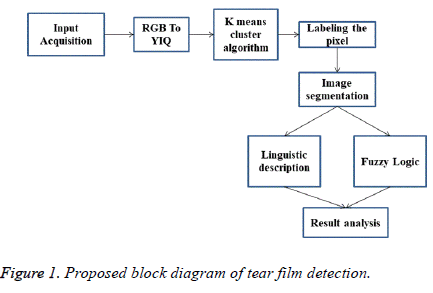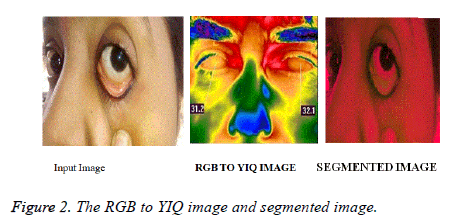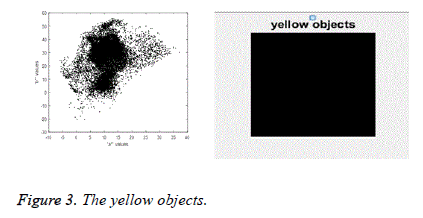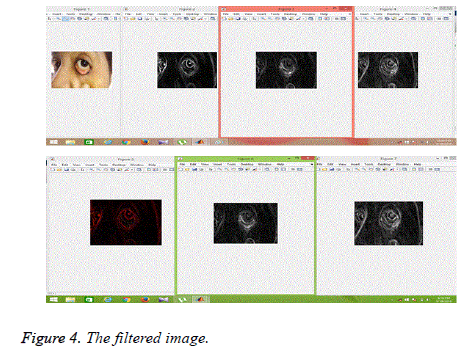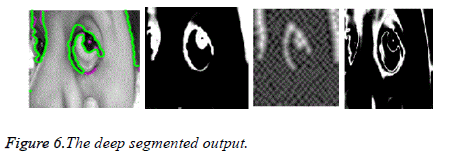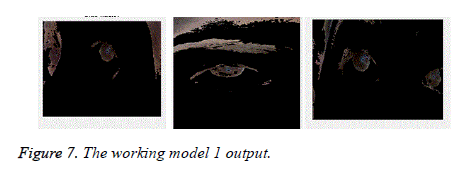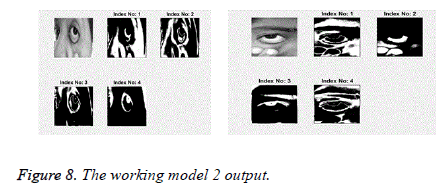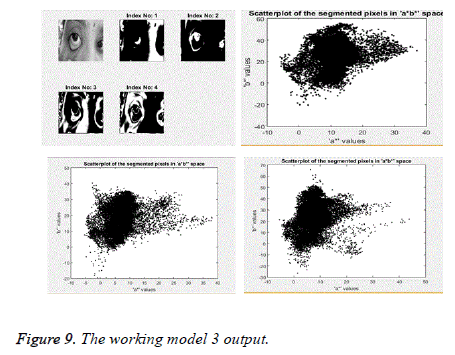Research Article - Biomedical Research (2020) Volume 31, Issue 4
Non-invasive tear-film detection using fuzzy c-means clustering algorithm for biomedical application
1Department of ECE, Saveetha School of Engineering, Chennai, India
2Department of ECE, Dr Rangarajan Dr Sakunthala Engineering College, Chennai, India
Accepted date: May 18, 2020
Abstract
Tear film recognizes as a significant problem in and around the world. The children at the age of 7 to the people around the age of 65 suffering from dry eye syndrome. The tear film must be detected at an early stage to protect the person from death.The tear film should be a monitor at the initial stage and diagnose by the unique technique, whether it may be the invasive or non-invasive method of dry detection. The invasive approach is the time-consuming process, and many disadvantages in this method arise in tear film detection. The non- invasive technique is not said to be a slow process. So the author proposed the novel approach of tear film detection by fuzzy c means clustering algorithm. The sample of eye images are taken and processed with fuzzy c means clustering algorithm and finds the intensity in both the eye. The accuracy analysis carried by fuzzy c indicates a clustering algorithm of 82% in its efficiency.
Keywords
Dry eye syndrome, Invasive and on invasive method, Fuzzy c means clustering, Accuracy
Introduction
Dry eye syndrome causes a person doesn't have enough quality of tears to lubricate and nourish the eye. The tears are necessary for maintaining the health care of the front surface of the eye and provide a clear vision. The Dry eye is often a chronic problem, particularly for older adults. The blink of the eyelids spread across the front surface of the eye. The Tears provide lubrication; reduce the risk of eye infection. The foreign matter in the eye keeps the cover of the eyes smooth and clear. The tears in the eyes flow into small drainage ducts in the inner corners of the eyelids. The Dry eyes can occur when tear production and drainage is not in balance stage-the tears produced by many glands in and around the eyelids. The tear production tends to diminish with age, with various medical conditions or as a side effect of certain medicines. Environmental health, such as wind and dry climates, can also decrease tear volume due to increased tear evaporation. When the average amount of tear production decreases or tears evaporate too quickly from the eyes, symptoms of dry eye can develop. Tears made up of three layers such as oil, water and mucus, respectively. The component protects and nourishes the front surface of the eye layer. The smooth oil layer helps to prevent evaporation of the water layer, while the mucin layer spreads the tears on the surface of the dry eye diseases. The tears evaporate quickly or do not spread evenly over the cornea. The dry eyes occur when the water layer of tears is inadequate in its lipids. People with Tear eyes experience irritated, scratchy or burning eyes. The Advanced dry eyes damage the front surface of the eye and vision. Many treatments for dry eyes aim to restore or maintain the average tears in the eye syndrome. To minimize the dryness related discomfort and to maintain a healthy condition.
Related Work
The analysis of meibomian gland area evaluates the luminance by enhancing the contrast also well defined, and the image noise s automatically reduced in this process of developing the software. Meanwhile, the meibomian gland area evaluates the treatment of dysfunction [1]. Glaucoma is a non-curable disease authorized by the people. Glaucoma can be detected on a cup to disc ratio using fuzzy c means clustering algorithm. The image captured identified from the colour whether the disease in early, moderate and severe. The condition detects at an early stage by the cup to disc ratio of fuzzy c means clustering algorithm [2]. Automatic detection of eye problem arises from the itching the eye from the ocular surface of the retinal region. The fluorescing liquid is dropped on the ocular surface from the lower eyelid to upper eyelid and locates the problem in the iris. The novel RANSAC method proposed to overcome the disease identified automatically [3]. Due to the increase in the fluorescent liquid cause’s damage in the ocular surface area and a decrease in the fluorescein liquid, the cost is very less. So there is the insulation of liquid level proposed by the author will not damage the ocular surface area. So there is a break up analyzed in the fluorescent level [4]. The non-invasive tear film method proposed to identify the disease in the early stage. The process tested with the device, and it takes time with the prospective output for nearly two weeks. The major disadvantage in the proposed method. Some other technique needs to introduce and detect inevasible tear film break up time as the limiting factor [5]. Videokeratoscopy is a high-speed technique to analyze the dry problem in the early stage of the diagnostics method. The on the invasive process of haemostatic can e cured at the initial step. So the novel method is proposed to analyze the haemostatic in the first stage of tear film break up time [6]. Two unique way BU and BUT suggested to explain which method efficiently improves the result in dry eye monitoring the ocular surface area. The two methods concentrate on the lipid layers, which can be diagnosed at the early stage [7]. Experiments demonstrate the robustness of the proposed method, which outperforms to create tear film and provides accurate results in comparison with clinicians. The proposed method helps to promote its clinical use for diagnosis and treatment [8]. The proposed method is to train deep convolution neural network for automatically detecting the punctuate dots in the ocular surface. And then we obtain a value, called CNN-SPK value, which represents the coverage of punctuating dots to improve the efficiency of the dry eye diagnosis treatment [9]. Computer-aided detection s preferred for Dry eye diagnosis. The CAD techniques automatically diagnose the DED and focus on thermographic CAD systems. The CAD systems for DED thermograph found to be highly sensitive. Furthermore, the deep learning techniques re-discussed to conventional machine learning techniques in dry eye detection [10].
Methodology
The devices fabricated to test the eye problems in the real-time scenario. The methods which are made by the computerized test are cost-effective technique and requires vast space in the internal structure. Moreover, the time is taken for the testing also massive. To save the time as well as internal structure fuzzy algorithm is optimized to test the tear film eye detection. In the existing method, the error ratio cannot be predictable in the early stage of the diagnostics of dry eye problem. The future development is to help the government to make the eye disease can test with the low-cost compatible device using fuzzy c means clustering algorithm. Figure 1 represents the proposed block diagram of dry detection using segmentation of fuzzy c means algorithm in the early stage of diagnostics. Moreover, the obtained result is compared with the linguistic variable to analyze the consequence accurately (Figures 1- 9).
Conclusion
A new method for automatic detection of the tear film breakup area developed his plan will be tested on more massive data sets and provides a comprehensive evaluation.The technique is clinically useful by the optometrists. The long term goal is to implement a non-invasive method to detect the stability of the tear film automatically.
References
- Arita R, Suehiro J, Haraguchi T, Shirakawa R, Tokoro H, Amano S. Objective image analysis of the meibomian gland area. Br J Ophthalmol 2014 ; 98: 746-755.
- Kakati M, Sarma P. Human pose detection: A machine learning approach. ininternational conference on computational vision and bio inspired computing. Springer 2019 ; 1: 8-18.
- Jiang S, Counsell SJ, Xue H, Allsop JM, Rutherford MA, Rueckert D, Hajnal JV. In-utero 3D high resolution fetal brain diffusion tensor imaging. Intl Soc Mag Reson Med 2007 ; 15: 661.
- King-Smith PE, Ramamoorthy P, Braun RJ, Nichols JJ. Tear film images and breakup analyzed using fluorescent quenching. Invest Ophthalmol Visual Sci 2013 ; 54: 6003-6011.
- Lee R, Yeo S, Aung HT, Tong L. Agreement of noninvasive tear break-up time measurement between Tomey RT-7000 Auto Refractor-Keratometer and Oculus Keratograph 5M. Clin Ophthalmol 2016 ; 10: 1785.
- Llorens-Quintana C, Szczesna-Iskander D, Iskander DR. Supporting dry eye diagnosis with a new method for noninvasive Tear film quality assessment. Optomet Vision Sci 2019 ; 96: 103-110.
- Christopher AM. Public Access: Physiological Behavior. 2016.
- Remeseiro B, Mosquera A, Penedo MG. CASDES: a computer-aided system to support dry eye diagnosis based on tear film maps. IEEE J Biomed Health Informat 2015 ; 20: 936-943.
- Su TY, Ting PJ, Chang SW, Chen DY. Superficial Punctate Keratitis Grading for Dry Eye Screening using Deep Convolutional Neural Networks. IEEE Sensors J 2019 ; 2: 1.
- Vicnesh J, Oh SL, Wei JK, Ciaccio EJ, Chua KC, Tong L, Acharya UR. Thoughts concerning the application of thermogram images for automated diagnosis of dry eye-A review. Infrared Phys Technol 2020 ; 8: 103271.
